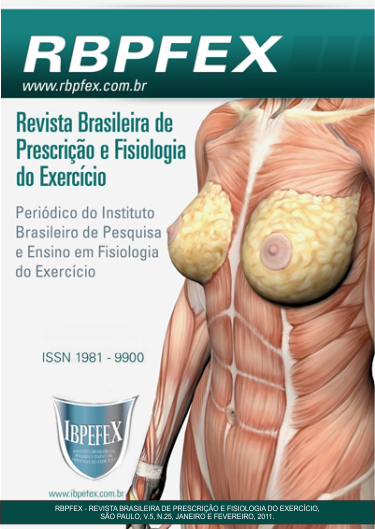Cardiovascular Response in Strenght Training Using Diferents Rest Intervals
Abstract
This study aimed to determine the acute effect of different rest intervals between sets on the hemodynamic responses in normotensive subjects submitted to a strength training session. Ten men (22 ± 3.14 years; 1.77 ± 0.09 m; 73.12 ± 5.43 kg) experienced at least two years in strength training. Each subject took a leg extension in two different sessions at rest intervals of 1 and 3 minutes. They performed 4 sets of 80% of 10RM in each session. The heart rate increased during the sets progressed, though there was no difference significantly between the two protocols for this variable. Systolic blood pressure increased from rest to the first set in the two protocols, and from there, there was a tendency to stabilize the same. There were not significant differences between to two protocols. In both protocols the rate-pressure product (RPP) increased from rest to the first set, but there were significant difference between two protocols only to the fourth set. The results show that there was no significant difference between the protocols for the variables studied, except for the fourth set of RPP, which showed higher in group that had 1 minute of rest interval.
References
- Brum, P.; e colaboradores. Adaptações agudas e crônicas do exercício físico no sistema cardiovascular. Revista Paulista de Educação Física. Vol18. 2004. p.21-31.
- Chobanian, A.V.; e colaboradores. Seventh report of the Joint National Committee on Prevention, Detection, Evaluation, and Treatment of High Blood Pressure. Hypertension. Vol. 42. Num. 6. 2003. p. 1206-1252.
- Cuckson, A.; e colaboradores. British Hypertension Society. Validation of the Microlife BP 3BTO-A oscillometric blood pressure monitoring device according to a modified British Hypertension Society protocol. Blood Press Monit. Vol. 7. Num 6. 2002. p. 319-324.
- D’Assunção, W.; e colaboradores. Respostas cardiovasculares agudas no treinamento de força conduzido em exercícios para grandes e pequenos grupamentos musculares. Rev Bras Med Esporte. Vol 13. Num. 2. 2007. p.118-122.
- Gotshall, R.; e colaboradores. Noninvasive characterization of the blood pressure response to the double-leg press exercise. J Exercise Physiol. Vol 2. Num 4. 1999. p. 116-120. Revista Brasileira de Prescrição e Fisiologia do Exercício. São Paulo. Vol. 5. Num. 25. Jan/Fev. 2011. p. 69-74.
– Kleiner, D.M.; e colaboradores. A description of the acute cardiovascular responses to isokinetic resistance at three different speeds. J Strength Cond Res. Vol. 13. Num. 4. 1999. p. 360-366.
- Kraemer, W.J.; e Ratamess N.A. Fundamentals of resistance training: progression and exercise prescription. Med Sci Sports Exerc. Vol. 36. Num. 4. 2004. p. 674-688.
- McCartney, N.; e colaboradores. The effects of strength training in patients with selected neuromuscular disorders. Med Sci Sports Exerc. Vol. 20. Num. 4. 1988. p. 362-368.
- McCarthy, J.P.; e colaboradores. Compatibility of adaptive responses with combining strength and endurance training. Med Sci Sports Exerc. Vol. 27. Num. 3. 1995. p. 429-436.
- Miranda, H.; e colaboradores. Verificação da frequência cardíaca, pressão arterial e duplo-produto em diferentes posições corporais no treinamento de força. Rev Treinamento Desportivo. Vol. 7. Num. 1. 2006. p. 68-72.
- Miranda, H.; e colaboradores. Análise da frequência cardíaca, pressão arterial e duplo-produto em diferentes posições corporais nos exercícios resistidos. Rev Bras Med Esporte. Vol. 11. Num. 5. 2005. p. 295-298.
- Miranda, H.; e colaboradores. Estudo da frequência cardíaca, pressão arterial e duplo-produto em diferentes números de séries durante exercícios resistidos. Arquivos em Movimento. Vol. 3. Num. 1. 2007. p. 29-38.
- Pickering ,T.G.; e colaboradores. Recommendations for blood pressure measurement in humans and experimental animals. Part 1: blood pressure measurement in humans. A statement for professionals from the Subcommittee of Professional and Public Education of the American Heart Association Council on High Blood. Hypertension. Vol. 45. 2005. p.142-161.
- Polito, M.D.; Farinatti P.T.V. Respostas de frequência cardíaca, pressão arterial e duplo-produto ao exercício contra resistência: uma revisão de literatura. Rev Port Ciências do Desporto. Vol. 3. Num. 1. 2003. p. 79-91.
- Polito, M.D.; e colaboradores. Série fracionada da extensão de joelho proporciona maiores respostas cardiovasculares que séries contínuas. Arq Bras Cardiol. Vol. 90. Num. 6. 2008. p.382-387.
- Polito, M.D.; e colaboradores. Pressão arterial, frequência cardíaca e duploproduto em séries sucessivas do exercício de força com diferentes intervalos de recuperação. Rev Port Ciências do Desporto. Vol. 4. 2004. p. 7-15.
- Pollock, M.L; e colaboradores. Resistance exercise in individuals with and without cardiovascular disease: benefits, rationale, safety and prescription: an advisory from the Committee on Exercise, Rehabilitation, and Prevention, Council on Clinical Cardiology. American Heart Association. Circulation. Vol. 101. 2000. p. 828-33.
- Shephard, R.J. PAR-Q, Canadian home fitness test and exercise screening alternatives. Sports Med. Vol 5. 1988. p.185-95.
- Veloso, U.; Monteiro, W.; Farinatti, P. Exercícios contínuos e fracionados provocam respostas cardiovasculares similares em idosas praticantes de ginástica? Rev Bras Med Esporte. Vol 9. Num 2. 2003. p. 78-84.
Authors who publish in this journal agree to the following terms:
- Authors retain the copyright and grant the journal the right of first publication, with work simultaneously licensed under the Creative Commons Attribution License BY-NC which allows the sharing of the work with acknowledgment of the authorship of the work and initial publication in this journal.
- Authors are authorized to enter into additional contracts separately for non-exclusive distribution of the version of the work published in this journal (eg, publishing in institutional repository or book chapter), with acknowledgment of authorship and initial publication in this journal.
- Authors are allowed and encouraged to post and distribute their work online (eg, in institutional repositories or on their personal page) at any point before or during the editorial process, as this can bring about productive change as well as increase impact and impact. citation of published work (See The Effect of Free Access).






